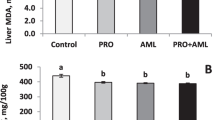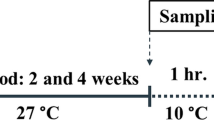Abstract
Haematological alterations in Fenneropenaeus indicus fed marine yeast glucan-incorporated diet and challenged with white spot syndrome virus were analysed. Adult F. indicus 16.45 ± 2.12 g (mean ± SD) were reared in 25 ‰ sea water and allowed to acclimate for a period of 7 days. Diet was prepared incorporating glucan (0.2 %) extracted from marine yeast, Debaryomyces hansenii S169. The shrimps were reared on experimental diet for 28 days and then challenged with white spot syndrome virus through oral administration. Random sampling was done (n = 6 shrimps) on 1st, 15th and 28th day of the experiment and on post-challenge day 2 (PCD 2) and PCD 7 for haematological analysis. The immune parameters viz. plasma protein, total haemocyte count, phenoloxidase activity, superoxide anion production, alkaline phosphatase and acid phosphatase activities were estimated in the haemolymph. Superoxide dismutase, catalase, glutathione peroxidase, hydroperoxide, conjugated dienes and malondialdehyde concentrations in the haemolymph of shrimps were also analysed. Analysis of variance showed that there are significant differences (p < 0.05) in the immune and antioxidant parameters in different treatment groups of F. indicus. The shrimps fed glucan-incorporated diet showed higher survival rate with comparatively lower accumulation of lipid peroxidation products. Correlation coefficients showed that all haematological variables except hydroperoxides and conjugated dienes exhibited positive correlation with the survival rate. The immune variables and antioxidant parameters exhibited a greater degree of correlation with each other. When multiple regression of survival rate on all immune parameters was considered, the amount of variability explained was 93 % (R Square = 0.932). When significant regression coefficients among the immune parameters were taken into account, it was found that total haemocyte count (p < 0.001), phenoloxidase activity (p < 0.05), alkaline phosphatase activity (p < 0.05) and plasma protein concentration (p < 0.05) together are explaining 84 % (R 2 = 0.842) of the variability, indicating that these four parameters are mainly supporting the survival. The amount of variability explained by the antioxidant parameters was 94 % (R 2 = 0.938). When significant regression coefficients among the antioxidant parameters were taken into account, it was found that superoxide dismutase activity (p < 0.01) and catalase activity (p < 0.05) together are explaining 87.4 % (R 2 = 0.874) of the variability, indicating that these two antioxidants act as the major immune effectors supporting the survival in shrimps.













Similar content being viewed by others
References
APHA (1995) In: Eaton AD, Clescenri LS, Greenberg AE (eds) Standard methods for the examination of water and wastewater. American Public Health Association, Washington
Beckage NE (1996) Interactions of viruses with invertebrate cells. In: Soderhall K, Iwanaga S, Vasta GR (eds) New directions in invertebrate immunology, SOS Publication, New York, pp 375–399
Bradford MM (1976) A rapid and sensitive method for the quantification of microgram quantities of protein using the principle of protein dye binding. Anal Biochem 72:248–254
Campa-Cordova AI, Hernandez-Saavedra NY, De Philippis R, Ascencio F (2002) Generation of superoxide anion and SOD activity in haemocytes and muscle of American white shrimp (Litopenaeus vannamei) as a response to β-glucan and sulphated polysaccharide. Fish Shellfish Immunol 12:353–366
Chang CF, Su MS, Chen HY (1999) A rapid method to quantify total haemocyte count of Penaeus monodon using ATP analysis. Fish Pathol 34:211–212
Chang CF, Chen HY, Su MS, Liao IC (2000) Immunomodulation by dietary β-1,3-glucan in the brooders of the black tiger shrimp, Penaeus monodon. Fish Shellfish Immunol 10:505–514
Chang CF, Su MS, Chen HY, Liao IC (2003) Dietary-1,3-glucan effectively improves immunity and survival of Penaeus monodon challenged with white spot syndrome virus. Fish Shellfish Immunol 15:297–310
Dalmo RA, Bogwald J (2008) Beta-glucans as conductors of immune symphonies. Fish Shellfish Immunol 25:384–396
Dandapat J, Chainy GBN, Rao KJ (2003) Lipid peroxidation and antioxidant defence status during larval development and metamorphosis of giant prawn Macrobrachium rosenbergii. Comp Biochem Physiol C 135:221–233
Fridovich I (1989) Superoxide dismutases an adaptation to a paramagnetic gas. J Biol Chem 264:7761–7764
Gonzalez F, Esther Ferez-Vidal M, Arias JM, Mantoya E (1994) Partial purification and biochemical properties of acid and alkaline phosphatases from Myxococcus coralloides D. J Appl Bacteriol 77:567–573
Hall MR, van Ham EH (1998) The effects of different types of stress on blood glucose in the giant tiger prawn Penaeus monodon. J World Aquacult Soc 29:290–299
Itami T, Takahashi Y, Tsuchihira E, Igusa H (1994) Enhancement of disease resistance of kuruma prawn Penaeus japonicus and increase in phagocytic activity of prawn haemocytes after oral administration of β-1,3-glucan (Schizophyllan). In: Chou LM, Munro AD, Lam TJ, Chen TW, Cheong LKK, Ding JK, Hooi KK, Khoo HW, Phang VPE, Shim KF, Tan CH (eds) Proceedings of the third Asian Fisheries Forum, Singapore, 26–30 October 1992. Asian Fisheries Society, Manila, pp 375–378
Itami T, Asano M, Tokushige K (1998) Enhancement of disease resistance of Kuruma shrimp, Penaeus japonicus after oral administration of peptidoglycan derived from Bifidobacterium thermophilum. Aquaculture 164:277–288
Kakkar P, Das B, Viswanathan DN (1984) A Modified spectrometric assay of superoxide dismutase. Ind J Biochem Biophys 21:130
Le Moullac G, Haffner P (2000) Environmental factors affecting immune response in crustacea. Aquaculture 191:12–131
Le Moullac G, Soyez C, Saulnier D (1998) Effect of hypoxic stress on the immune response and the resistance to vibriosis of the shrimp Penaeus stylirostris. Fish Shellfish Immunol 8:621–629
Lin T, Xing J, Jiang J, Tang X, Zhan W (2011) β-glucan-stimulated activation of six enzymes in the haemocytes of the scallop Chlamys farreri at different water temperatures. Aquaculture 315:213–221
Liu SQ, Jiang XL, Mou HJ, Wang HM, Guan HS (1999) Effects of immunopolysaccharide on LSZ, ALP, ACP and POD activity of Penaeus chinensis serum. Oceanol Limnol Sinica 30:278–283
Liu XL, Xi QY, Yang L, Li HY, Jiang QY, Shu G, Wang SB, Gao P, Zhu XT, Zhang YL (2011) The effect of dietary Panax ginseng polysaccharide extract on the immune responses in white shrimp, Litopenaeus vannamei. Fish Shellfish Immunol 30:495–500
Lo CF, Leu JH, Ho CH, Chen CH (1996) Detection of baculovirus associated with white spot syndrome (WSBV) in penaeid shrimps using polymerase chain reaction. Dis Aquat Org 25:133–141
Lo CF, Ho CH, Chen CH, Liu KF, Chiu YL, Yeh PY (1997) Detection and tissue tropism of white spot syndrome baculovirus (WSBV) in captured brooders of Penaeus monodon with a special emphasis on reproductive organ. Dis Aquat Org 30:53–72
Machly AC, Chance B (1955) Assay of catalases and peroxidases. In: Colowick SP, Kaplan NO (eds) Methods of biochemical Analysis, vol 2, Academic Press, New York, pp 764
Mair RD, Hall T (1977) In: Swem C, Witky (eds) Inorganic peroxides. Intersciences, New York, pp 532
Mar Costa M, Novoa B, Figueras A (2008) Influence of β-glucans on the immune responses of carpet shell clam (Ruditapes decussatus) and Mediterranean mussel (Mytilus galloprovincialis). Fish Shellfish Immunol 24:498–505
Mathew S, Ashok Kumar K, Anandan R, Viswanathan Nair PG, Devadasan K (2007) Changes in tissue defence system in white spot syndrome virus (WSSV) infected Penaeus monodon. Comp Biochem Physiol C 145:315–320
Misra CK, Das BK, Pradhan J, Pattnaik P, Sethi S, Mukherjee SC (2004) Changes inlysosomal enzyme activity and protection against Vibrio infection in Macrobrachium rosenbergii (De Man) post larvae after bath immunostimulation with β-glucan. Fish Shellfish Immunol 17:389–395
Niehaus WG Jr, Samuelson B (1968) Formation of malondialdehyde from phospholipids arachidonate during microsomal lipid peroxidation. Eur J Biochem 6:126
Rajan PR, Ramasamy P, Purusothaman V, Brennan GP (2000) White spot baculovirus syndrome virus in the Indian shrimp Penaeus monodon and Penaeus indicus. Aquaculture 184:31–44
Recknagel RO, Ghoshal AK (1966) Quantitative estimation of peroxidative degeneration of rat liver micosomal and mitochondrial lipids after carbon tetrachloride poisoning. Exp Mol Path 5:413–426
Robertson L, Bray W, Leung-Trujillo J, Lawrence J (1987) A practical molt staging of Penaeus setiferus and Penaeus stylirostris. J World Aquacult Soc 18:180–185
Roch P (1999) Defense mechanisms and disease prevention in farmed marine invertebrates. Aquaculture 172:125–145
Rotruck JT (1973) Selenium: biochemical role as a component of glutathione peroxidase. Science 179:588–590
Sajeevan TP, Philip R, Singh ISB (2006) Immunostimulatory effect of a marine yeast Candida sake S165 in Fenneropenaeus indicus. Aquaculture 257:150–155
Sajeevan TP, Subramannian S, Philip R (2010) β-Mercapto-ethanol-treated yeast showed better protection against white spot syndrome virus infection in Indian white shrimp Fenneropenaeus indicus. Aquacult Res 41(10):e715–e718
Sang HM, Ky TL, Fotedar R (2009) Dietary supplementation of mannan oligosaccharide improves the immune responses and survival of marron, Cherax tenuimanus (Smith, 1912) when challenged with different stressors. Fish Shellfish Immunol 27:341–348
Shirali P, Teissier E, Marez T, Hildebrand HF, Haguenoer J (1994) Effect of alpha Ni3S2 on arachidonic acid metabolites in cultured human lung cells (L132 cell line). Carcinogenesis 15:759–762
Smith VJ, Soderhall K (1983) β-1,3-glucan activation of crustacean haemocytes in vitro and in vivo. Biol Bullet 164:299–314
Soderhall K (1981) Fungal cell wall β-1,3-glucans induce clotting and phenoloxidase attachment to foreign surfaces of crayfish haemocyte lysate. Dev Comp Immunol 5:565–573
Soderhall K, Cerenius L (1998) Role of the prophenoloxidase activating system in invertebrate immunity. Curr Opin Immunol 10:23–28
Song YL, Hsieh YT (1994) Immunostimulation of tiger shrimp, Penaeus monodon haemocytes for generation of microbicidal substances: analysis of reactive oxygen species. Dev Comp Immunol 18:201–209
Song YL, Liu JJ, Chan LC, Sung HH (1997) Glucan-induced disease resistance in tiger shrimp, Penaeus monodon. Fish Vaccinol Dev Biol Stand 90:413–421
Sung HH, Kou GH, Song YL (1994) Vibriosis resistance induced by glucan treatment in tiger shrimp, Penaeus monodon. Fish Pathol 29:11–17
Wang WN, Wang AL, Wang Y, Wang JX, Sun RY (2005) Effect of dietary vitamin C and ammonia concentration on the cellular defense response of Macrobrachium nipponense. J World Aquacult Soc 36(1):1–7
Williams DL, Mcnamee RB, Jones EL, Pretus HA, Ensley HE, Browder IW, Di Luzio NR (1991) A method for the solubilisation of a (1-3)-β-D-glucan isolated from Saccaromyces cerevisiae. Carbohydr Res 219:203–213
Yadomae T, Ohno N (1996) Structure-activity relationship of immunomodulating (1,3)-β-glucans. Recent Res Dev Chem Pharm Sci 1:23–33
Yemm EW, Cocking EC (1955) The determination of amino acids with ninhydrin. Analyst 80:209–213
Acknowledgments
The work was supported by the University Grants Commission, India, through the award of JRF and SRF. The authors gratefully acknowledge Cochin University of Science and Technology for providing necessary facilities.
Author information
Authors and Affiliations
Corresponding author
Rights and permissions
About this article
Cite this article
Subramanian, S., Philip, R. Identification of haematological markers in shrimp health assessment from the immune profile of Fenneropenaeus indicus on β-1,3-glucan administration and white spot syndrome virus challenge. Aquacult Int 21, 1169–1184 (2013). https://doi.org/10.1007/s10499-013-9621-1
Received:
Accepted:
Published:
Issue Date:
DOI: https://doi.org/10.1007/s10499-013-9621-1




